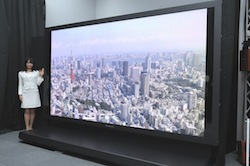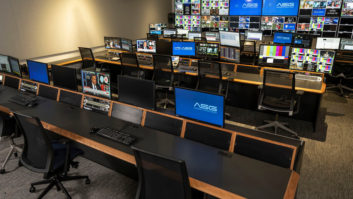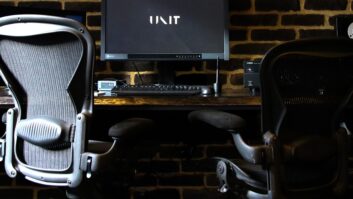
As NHK subjects Super Hi-Vision to its latest test, the BBC is evaluating practical production issues and audience research. A live mixing and editing platform is among the innovations planned for the Super Hi-Vision (SHV) production of the London Olympics by Japanese broadcaster NHK. A new lightweight camcorder is also being previewed (see below) but not used in the trials. The transmission of select live and recorded events is being made by NHK in concert with the BBC and Olympics Broadcasting Services and is being shown via JVC/NHK-built 8K (7,680 x 4,320 resolution) projectors at public theatres on over 50-foot tall screens in Bradford (National Media Museum), London (New Broadcasting House), Glasgow (Pacific Quay), Japan and Washington DC. For NHK the objective is to prove a number of technologies such as programme production with live relays, transmission over global IP networks, feeds to multiple areas and screening techniques for public venues. “The trial should provide us with plenty of know-how about producing content and screening formats,” said Dr Keiichi Kubota, director-general of science and technology research labs at NHK. “The public viewings will hopefully give people a good taste of what SHV can offer, and have us moving in the same direction for broadcasts of the future.” NHK is pursuing R&D covering all aspects of SHV broadcasts, from programme production to broadcasting facilities, as well as SHV TV sets for the home and is keen to produce a major arts event for its next live test. “We are steadily reducing the size of camera and have also developed larger capacity terrestrial transmission which has enabled us to carry out the first-ever field experience of the terrestrial SHV transmission,” said Kubota. “We have devised image sensors for SHV cameras to capture fast-moving objects more clearly at 120 frames per second with the ultimate objective of perfecting a 120Hz frame rate. And we have developed a high frame-rate SHV projector.” The current Super Hi-Vision system relies on a 60Hz dual-green format, but NHK want to maximise the potential to a 7,680×4,320 x RGB/YC, 120Hz format. “Our ultimate goal for SHV is to achieve its full potential standard-wise with a 120Hz frame rate and a wide-gamut system,” explained Kubota. “The standard was tentatively adopted at the ITU-R in April, and we are in the process of getting it approved.” The UltraHD TV standard in process of ratification at the ITU is SMPTE2036-1 (MPEG H.265 HEVC), which provides for a 120Hz frame rate. Household screens NHK is also founder member of the Future of Broadcast TV (FoBTV) project, which recognised UltraHDTV as an effective application for future terrestrial broadcasts. “We hope SHV will be adopted across the world via FoBTV,” said Kubota. “Hopefully, we will be able to come up with the first-ever uniform standard for terrestrial telecasts.” There are a number of technical challenges lying ahead of the proposed 2015 domestic test transmission and a 2020 commercial launch (which may happily coincide with the 2020 Summer Olympics if Tokyo wins the bid). Among the difficulties are overcoming rain attenuation with 21GHz band satellites over Japan. “We are studying ways of solving the problem by controlling the satellite transmitting power in each region,” says Kubota. “We also have to overcome the issues of securing transmission channels, compression coding technology allowing for adequate resolution, and supplying SHV displays for the home.” The latter is being cracked. Following Sharp’s lead of an 85-inch 8K prototype LCD at CES2012, Panasonic has allied with NHK to develop a 145-inch 8K (7860×4320) plasma, one of which is showing SHV London 2012 content in a VIP screening room at the Olympic IBC. 4K screens will begin rolling into the market from 2013. LG, for example, has a 84-inch 4K screen also sporting 3D and smart TV features. NHK has even developed a touch panel interface to a screen that down-converts the content resolution from SHV to HD (though the display itself only has a resolution of 4K). The smallest SHV display is an 85-inch LCD, which Kubota says may be a feasible size for household use in the future. “We are pressing forward with our R&D on lighter displays with less energy consumption and studying the appropriate display sizes for viewing in the home,” says Kubota. While remote-controlled SHV cameras are still several years away, NHK is pondering whether to start development of compact recorders in the near the future. The shift to card-based editing systems is already being made since current SHV cameras use multiple Panasonic P2 cards to record and edit SHV images. According to Dr. Yoshiaki Shishikui, head of NHK’s Advanced Television Systems Research Division, “After 15 years we expect to develop the same level of usability as current HD devices but will still need large-capacity archive systems and higher-sensitivity cameras.” SHV camcorder NHK has unveiled a new compact Super Hi-Vision camera, which will be used to produce regular SHV content by 2014. The camera is not being used as part of the London Olympics test transmissions. NHK says it plans to start using the camera in SHV production by 2014 after further checks on performance and necessary improvements. “We have come up with a small SHV camera-head the same size as existing HD cameras,” explained Kubota. “It weighs only 4 kilos, or less than 20 per cent of the existing SHV cameras. Since the camera adopts the single-chip colour image sensor, the camera can be fitted with a range of the commercially available 35mm full-frame lens for single-lens reflex cameras.” The camcorder’s single 33 million pixel (7,680 across x 4,320 high) CMOS sensor can capture at 60 frames per second. The SHV signals from the camera are uncompressed and output at a data rate of about 24Gpps for recording variously onto a HDD, SSD or P2 recorder. Recording capacity is 20 to 50 minutes in HDD and SSD (uncompressed), or about two hours on P2 (compressed). The full performance specs of the unit, including senor sensitivity to light, will be released at an academic conference this month. Its power consumption is 45W. By Adrian Pennington






